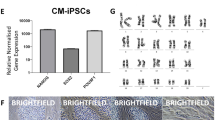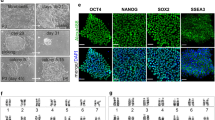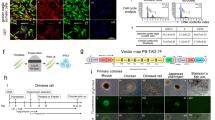Abstract
For some highly endangered species there are too few reproductively capable animals to maintain adequate genetic diversity, and extraordinary measures are necessary to prevent extinction. We report generation of induced pluripotent stem cells (iPSCs) from two endangered species: a primate, the drill, Mandrillus leucophaeus and the nearly extinct northern white rhinoceros, Ceratotherium simum cottoni. iPSCs may eventually facilitate reintroduction of genetic material into breeding populations.
This is a preview of subscription content, access via your institution
Access options
Subscribe to this journal
Receive 12 print issues and online access
$259.00 per year
only $21.58 per issue
Buy this article
- Purchase on Springer Link
- Instant access to full article PDF
Prices may be subject to local taxes which are calculated during checkout


Similar content being viewed by others
References
Takahashi, K. et al. Cell 131, 861–872 (2007).
Yu, J. et al. Science 318, 1917–1920 (2007).
Takahashi, K. & Yamanaka, S. Cell 126, 663–676 (2006).
Liu, H. et al. Cell Stem Cell 3, 587–590 (2008).
Oates, J.F. & Butynski, T.M. International Union for Conservation of Nature (IUCN) Red List of Threatened Species version 2011.1 (2008; accessed 5 April 2011).
Howard, C.F. Jr. & Palotay, J.L. Lab. Anim. Sci. 25, 191–196 (1975).
International Union for Conservation of Nature African Rhino Specialist Group. International Union for Conservation of Nature (IUCN) Red List of Threatened Species version 2011.1 (2008; accessed 5 April 2011).
Wang, Y.-C. et al. Cell Res. (in the press).
Trounson, A. Cell Stem Cell 4, 3–4 (2009).
Panula, S. et al. Hum. Mol. Genet. 20, 752–762 (2011).
Park, T.S. et al. Stem Cells 27, 783–795 (2009).
Yang, S. et al. J. Vet. Med. Sci. 73, 717–723 (2011).
Curnow, E.C. et al. Hum. Reprod. 25, 2465–2474 (2010).
Peluffo, M.C. et al. Biol. Reprod. 83, 525–532 (2010).
Nichols, S. et al. Reprod. Biomed. Online 20, 365–370 (2010).
Hermes, R. et al. Theriogenology 72, 959–968 (2009).
Barch, M.J., Knutsen, T. & Spurbeck, J.L., (eds.) The AGT Cytogenesis Laboratory Manual (3rd edn.) (Raven Press, 1997).
Houck, M.L., Ryder, O.A., Vahala, J., Kock, R.A. & Oosterhuis, J.E. J. Hered. 85, 30–34 (1994).
Acknowledgements
I.F.B.-N. was supported by an unrestricted gift from the Esther O'Keefe Foundation, and S.C.M. was supported by an internship from the California Institute for Regenerative Medicine (TB1-01186). The research was supported by the O'Keefe Foundation and the Millipore Foundation. We thank our collaborator, M. Parast, for the histopathological examination of the teratomas, I. Slavin, X. Liao and other members of the Loring lab for helpful discussions and assistance, and G. Ben-Nun and D. Barker for support.
Author information
Authors and Affiliations
Contributions
J.F.L., O.A.R. and I.F.B.-N. conceived the study. I.F.B.-N. designed and performed the experiments. S.C.M. assisted with tissue-culture work. O.A.R., M.L.H. and S.J.C. generated the fibroblast cell lines and karyotyped the cells. H.T.T., I.G. and T.R.L. assisted with teratoma formation. Y.-C.W. performed glycomic profiling. L.C.L. contributed to experiment design. I.F.B.-N. and J.F.L. wrote the manuscript with input from all authors.
Corresponding author
Ethics declarations
Competing interests
The authors declare no competing financial interests.
Supplementary information
Supplementary Text and Figures
Supplementary Figures 1–11, Supplementary Table 1 (PDF 2590 kb)
Rights and permissions
About this article
Cite this article
Friedrich Ben-Nun, I., Montague, S., Houck, M. et al. Induced pluripotent stem cells from highly endangered species. Nat Methods 8, 829–831 (2011). https://doi.org/10.1038/nmeth.1706
Received:
Accepted:
Published:
Issue Date:
DOI: https://doi.org/10.1038/nmeth.1706
This article is cited by
-
Integration-free induced pluripotent stem cells from three endangered Southeast Asian non-human primate species
Scientific Reports (2024)
-
Will these reprogrammed elephant cells ever make a mammoth?
Nature (2024)
-
The impact of induced pluripotent stem cells in animal conservation
Veterinary Research Communications (2024)
-
Fish cell line: depositories, web resources and future applications
Cytotechnology (2024)
-
Current advances in primate genomics: novel approaches for understanding evolution and disease
Nature Reviews Genetics (2023)



